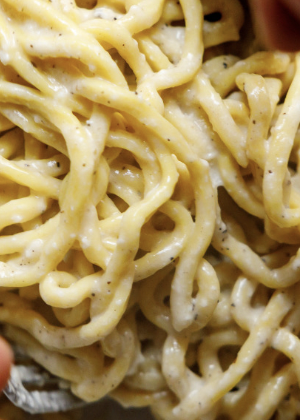If you’re reading this, you likely know that we take our food very, very seriously at Italy Segreta. It’s not uncommon to find us dissecting recipes and arguing about the optimal variety of tomato, or what the best way to cook broccoli is. And of course, when it comes to the infinite and minute variations on classic Italian dishes, the atmosphere at the office can get downright heated. In order to settle it once and for all, we’ll be taking the time to workshop and taste-test beloved recipes from Italy’s different cities and regions, in the aim of agreeing on the one, ultimate, reigning recipe. We’re not saying this is the most historically accurate or traditional way of cooking these recipes–there are plenty of other places you can go for those methods–this is just our highly opinionated editorial board’s collective favorite way. Approved by both the Italian and international contingents.
Cacio e pepe has gone from being a local Roman dish to a global obsession, and while some of you are forking over a few too many euros for silky sauces at the capital’s finest, we prefer to make the pasta at home. With just three ingredients, cacio e pepe is quite simple–on the surface. In reality, it’s all about balance, temperature, and ratio: too much water and you’ll end up with something soupy; if the water is too hot (above 70°C), your cheese will be unbearably stringy; not enough pepper, and you’re basically eating glorified mac and cheese; too much pepper, and, well, good luck to your taste buds. Some recipes call for a mixture of Pecorino Romano and Parmigiano Reggiano, but we’re partial to the original which calls for just the former. Below, our tried and true recipe for the iconic dish; don’t be discouraged if it takes a few times to master!
ITALY SEGRETA’S CACIO E PEPE
Serves 4
INGREDIENTS
- 300 grams spaghetti (or tonnarelli, rigatoni, mezze maniche)
- 100 grams Pecorino Romano, grated
- 1 – 2 teaspoons cracked black pepper, depending on preference
- Salt
PREPARATION
- Bring a pot of lightly-salted water to a boil–the key is to salt the water just enough to compliment but not overpower the salt from the Pecorino.
- Add the pasta and boil until al dente.
- About two minutes before the pasta is al dente, heat a saucepan over low-to-medium heat. Add the ground pepper and lightly toast. Then, add in the grated Pecorino, reserving about one-third. Stir together while adding a small ladle of pasta water. Turn the heat to low.
- When the pasta is done, shut the burner off. Don’t drain the pasta: instead, lift directly out of the pot into the saucepan using either tongs or a slotted spoon, depending on the shape; the residual water on the pasta will help emulsify and create the sauce.
- Toss pasta vigorously with the sauce, adding in the rest of the reserved Pecorino. You can add more pasta water if it looks dry, but only a tiny bit at a time!
- Once properly coated, shut the burner off. Serve immediately with more cracked pepper and freshly grated Pecorino.




